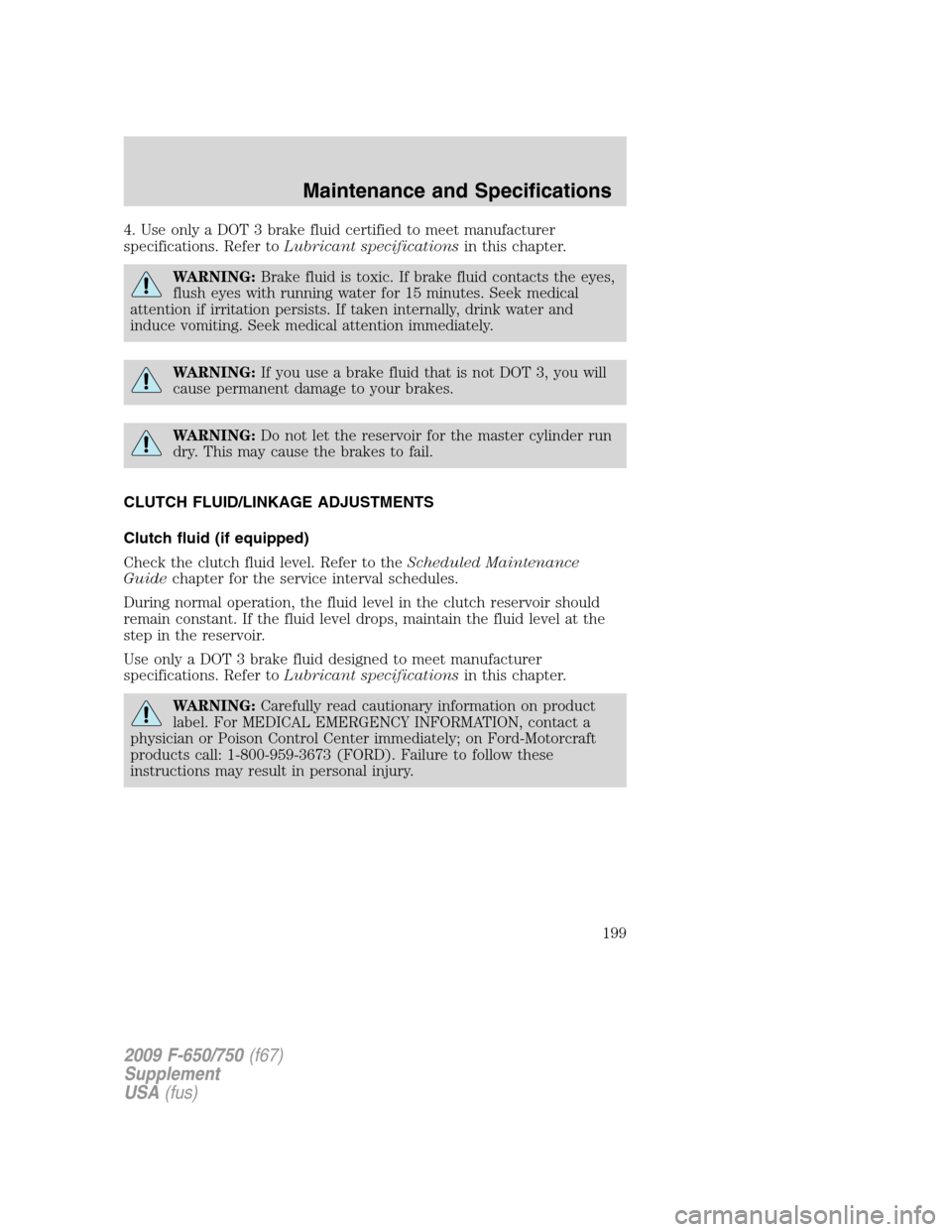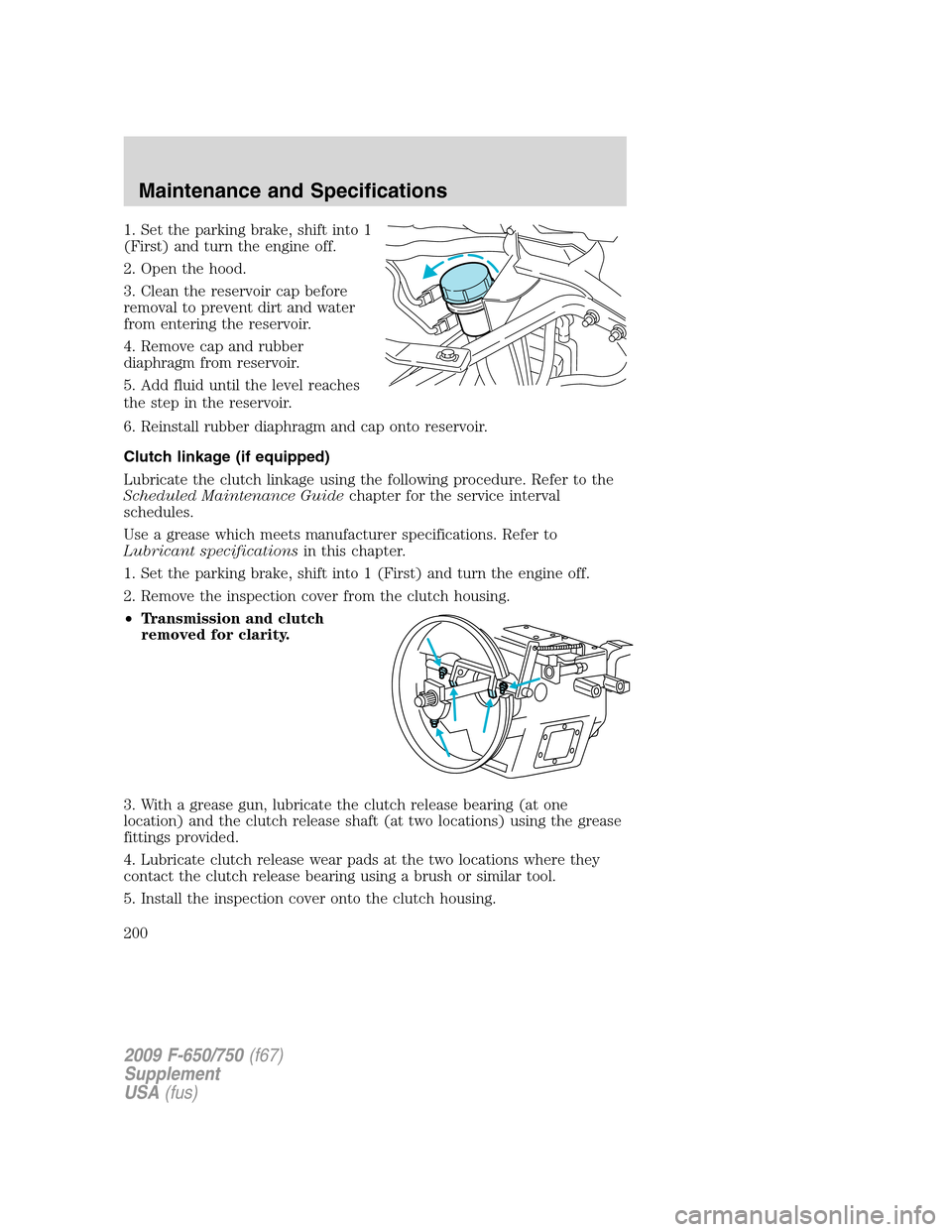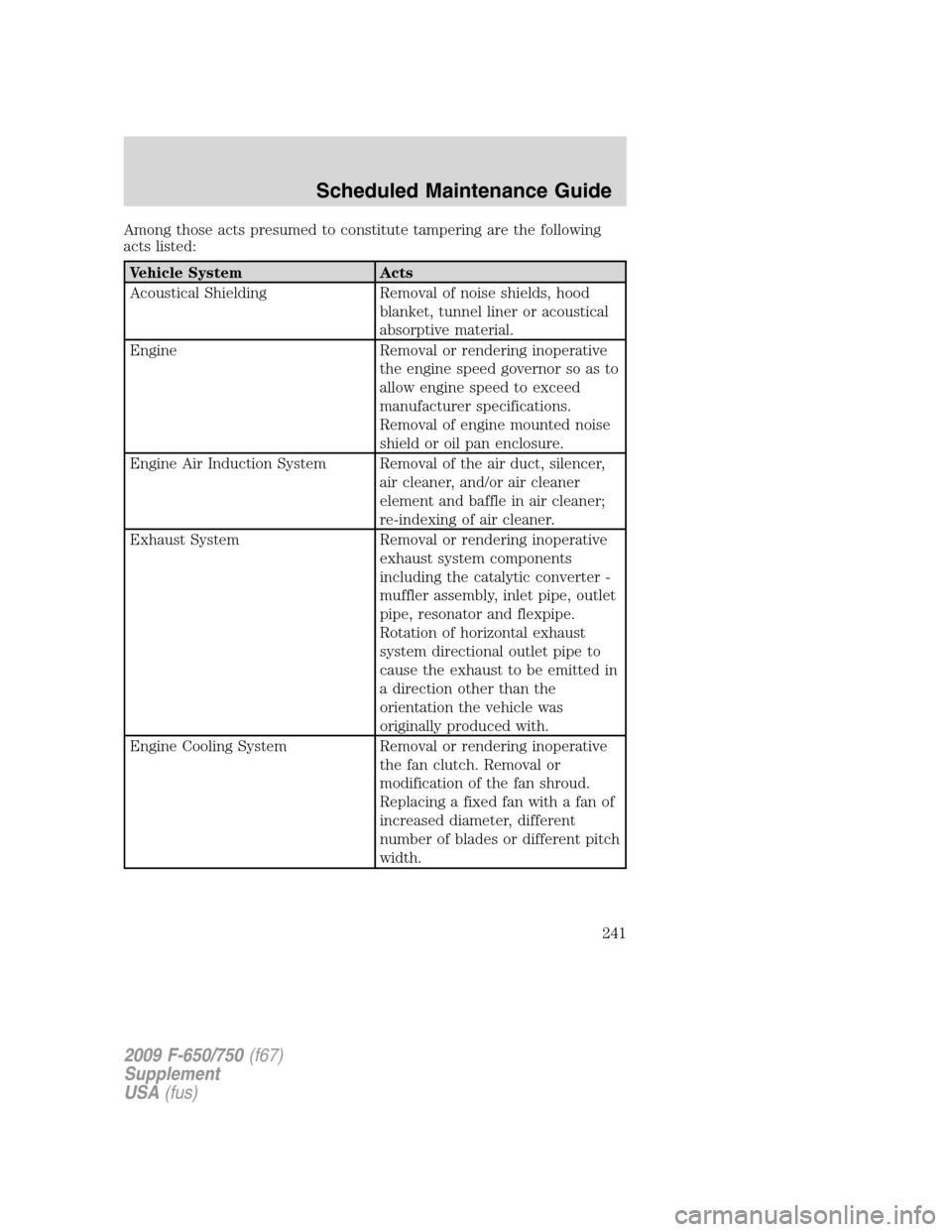Page 199 of 276

4. Use only a DOT 3 brake fluid certified to meet manufacturer
specifications. Refer toLubricant specificationsin this chapter.
WARNING:Brake fluid is toxic. If brake fluid contacts the eyes,
flush eyes with running water for 15 minutes. Seek medical
attention if irritation persists. If taken internally, drink water and
induce vomiting. Seek medical attention immediately.
WARNING:If you use a brake fluid that is not DOT 3, you will
cause permanent damage to your brakes.
WARNING:Do not let the reservoir for the master cylinder run
dry. This may cause the brakes to fail.
CLUTCH FLUID/LINKAGE ADJUSTMENTS
Clutch fluid (if equipped)
Check the clutch fluid level. Refer to theScheduled Maintenance
Guidechapter for the service interval schedules.
During normal operation, the fluid level in the clutch reservoir should
remain constant. If the fluid level drops, maintain the fluid level at the
step in the reservoir.
Use only a DOT 3 brake fluid designed to meet manufacturer
specifications. Refer toLubricant specificationsin this chapter.
WARNING:Carefully read cautionary information on product
label. For MEDICAL EMERGENCY INFORMATION, contact a
physician or Poison Control Center immediately; on Ford-Motorcraft
products call: 1-800-959-3673 (FORD). Failure to follow these
instructions may result in personal injury.
2009 F-650/750(f67)
Supplement
USA(fus)
Maintenance and Specifications
199
Page 200 of 276

1. Set the parking brake, shift into 1
(First) and turn the engine off.
2. Open the hood.
3. Clean the reservoir cap before
removal to prevent dirt and water
from entering the reservoir.
4. Remove cap and rubber
diaphragm from reservoir.
5. Add fluid until the level reaches
the step in the reservoir.
6. Reinstall rubber diaphragm and cap onto reservoir.
Clutch linkage (if equipped)
Lubricate the clutch linkage using the following procedure. Refer to the
Scheduled Maintenance Guidechapter for the service interval
schedules.
Use a grease which meets manufacturer specifications. Refer to
Lubricant specificationsin this chapter.
1. Set the parking brake, shift into 1 (First) and turn the engine off.
2. Remove the inspection cover from the clutch housing.
•Transmission and clutch
removed for clarity.
3. With a grease gun, lubricate the clutch release bearing (at one
location) and the clutch release shaft (at two locations) using the grease
fittings provided.
4. Lubricate clutch release wear pads at the two locations where they
contact the clutch release bearing using a brush or similar tool.
5. Install the inspection cover onto the clutch housing.
2009 F-650/750(f67)
Supplement
USA(fus)
Maintenance and Specifications
200
Page 223 of 276
ComponentLubrication
typeViscosity /
Ambient
temperature /
NotesEquivalent
Ford part
name /
number
Driveshaft
U-joint GC/LB NLGI #2
lithium
complex-based
moly grease or
multi-purpose
lithium
complex grease— Motorcraft
Premium Long
Life Grease /
XG-1-C
Clutch
Release bearing /
shafts / forkGC/LB NLGI #2
lithium
complex-based
moly grease or
multi-purpose
lithium
complex grease— Motorcraft
Premium Long
Life Grease /
XG-1-C
Reservoir DOT 3,
ESA-M6C25–A
or
WSS-M6C62–A— Motorcraft High
Performance
DOT 3 Motor
Vehicle Brake
Fluid, PM-1 or
PM-1–C
2009 F-650/750(f67)
Supplement
USA(fus)
Maintenance and Specifications
223
Page 241 of 276

Among those acts presumed to constitute tampering are the following
acts listed:
Vehicle System Acts
Acoustical Shielding Removal of noise shields, hood
blanket, tunnel liner or acoustical
absorptive material.
Engine Removal or rendering inoperative
the engine speed governor so as to
allow engine speed to exceed
manufacturer specifications.
Removal of engine mounted noise
shield or oil pan enclosure.
Engine Air Induction System Removal of the air duct, silencer,
air cleaner, and/or air cleaner
element and baffle in air cleaner;
re-indexing of air cleaner.
Exhaust System Removal or rendering inoperative
exhaust system components
including the catalytic converter -
muffler assembly, inlet pipe, outlet
pipe, resonator and flexpipe.
Rotation of horizontal exhaust
system directional outlet pipe to
cause the exhaust to be emitted in
a direction other than the
orientation the vehicle was
originally produced with.
Engine Cooling System Removal or rendering inoperative
the fan clutch. Removal or
modification of the fan shroud.
Replacing a fixed fan with a fan of
increased diameter, different
number of blades or different pitch
width.
2009 F-650/750(f67)
Supplement
USA(fus)
Scheduled Maintenance Guide
241
Page 246 of 276

Check every oil change
Engine systemCheck the engine cooling system -
hoses, clamps and protection*.
Inspect the drive belts.
Exhaust systemInspect the entire exhaust system
(including the inlet pipe(s),
muffler(s), outlet pipe(s), clamps and
fasteners) for holes, leakage,
breakage, corrosive damage and
separation from other components.
Adjust, service or replace with the
same or the equivalent part. (Also a
noise emission control service).
Suspension systemTighten the front and rear spring
U-bolts to the specified torque.
Driveline and rear axle
systemLubricate the U-joints and the slip
yoke.
Brake systemLube the air brake foot control valve,
hinge and roller.
Inspect the drum brake linings
through the inspection holes.
Lubricate the brake camshafts (air
brakes only).
Lubricate the brake slack adjuster (air
brakes only).
Lubricate rear caliper slide rails.
Inspect the disc brake pads and the
piston boots (hydraulic brakes only).
Clutch systemLubricate the clutch release cross
shaft and all linkages.
Check the clutch fluid.
Fuel systemDrain the accumulated water or
sediment from the fuel tank(s).
2009 F-650/750(f67)
Supplement
USA(fus)
Scheduled Maintenance Guide
246
Page 247 of 276

Check every oil change
Steering systemLubricate the steering shaft(s),
U-joints and splines when equipped
with grease fittings.
Lubricate the front axle spindle pins.
Lubricate the steering linkage when
equipped with grease fittings.
Grease the power steering gear output
shaft.
* Coolant protection checks should be made just prior to the onset of
freezing weather, where applicable. If coolant is dirty or rusty in
appearance, the system should be drained, flushed and refilled with the
prescribed solution of cooling system fluid and water. Use only
permanent type coolant that meets specifications as listed in your
engine operator’s manual. See the engine manufacturer’s operating
guide for supplemental corrosion inhibitor specifications.
In addition to the items to be performed daily or at each oil change, the
following need to be completed as specified:
GENERAL MAINTENANCE SERVICES
The following are vehicle checks that should be made periodically either
by the owner or a qualified technician. It is recommended that
deficiencies be brought to the attention of your dealer or another
qualified service outlet as soon as possible in order that advice regarding
the need for service or replacement can be obtained.
Maintenance Operation Frequency - Observation
Inspect the automatic slack
adjuster functionInsufficient power shown in loaded
practice stop.
Check the operation of the
brakes, the clutch, and the
steering
(1),(2)
Vehicle handling qualities not up to
par.
Inspect the vehicle for missing,
damaged, or mislocated noise
shieldsExcessive noise emanates from under
the cab or engine compartment.
2009 F-650/750(f67)
Supplement
USA(fus)
Scheduled Maintenance Guide
247
Page 248 of 276

Maintenance Operation Frequency - Observation
Check the engine performance
and the engine governorExcessive engine noise.
Inspect the fan, the fan shroud,
and the fan clutchEngine overheats, fan runs at high
speed constantly, excessive fan noise,
or fan wobble due to worn bearings.
Check for operation of ABS
warning lampAt each engine start up.
Inspect the entire exhaust
system (including inlet pipe,
muffler, outlet pipe and all
exhaust clamps and fasteners)
for holes, leakage, breakage,
looseness and corrosive
damageExcessive noise or the smell of fumes
is experienced.
Inspect the engine air
induction system (including the
air ducts and the air filter) for
loose fitting, damaged or
missing componentsExcessive noise emanates from the
engine compartment.
Inspect the tires and check the
air pressure
(3)Poor steering, wandering or excessive
tire wear.
Balance the wheels and the
tiresVibration or abnormal tire wear
indicates imbalance.
Check the front end alignment
(3)Poor steering, wandering or excessive
tire wear.
Check the transmission and
engine mountings
(2)Hard shifting or excessive vibration.
Check and adjust transmission
controls
(2)High effort to shift or noisy
transmission.
Check fuel pump pressure Insufficient full-throttle power or
backfiring.
Clean radiator cap seal. Clean
and inspect the cap surface on
the radiatorWhen the cap does not hold pressure.
2009 F-650/750(f67)
Supplement
USA(fus)
Scheduled Maintenance Guide
248
Page 251 of 276
ON-HIGHWAY - 60,000 MILES (96,000 KM) OR MORE ANNUALLY (Continued)
(Miles, kilometers or months - whichever occurs first)
Miles (x 1000) 15 30 45 60 75 90 105 120 135 150
Kilometers (x 1000) 24 48 72 96 120 144 168 192 216 240
Months 3 6 9 12 15 18 21 24 27 30
Driveshaft SPL
U-joint - lubricate Every 100,000 miles (160,000 km) or six months, whichever
comes first
Driveshaft non-SPL
U-joint and slip joint - lubricate Every 10,000–15,000 miles (16,000–24,000 km) or three months,
whichever comes first
Clutch
Release bearing / shafts / forks - lubricate••••••••••
Cooling system
Coolant - check level••••••••••
Coolant - check freeze protection••••••••••
Extended life coolant - add extender See engine manufacturer’s recommendation
Extended life coolant - replace See engine manufacturer’s recommendation
2009 F-650/750(f67)
Supplement
USA(fus)
Scheduled Maintenance Guide
251